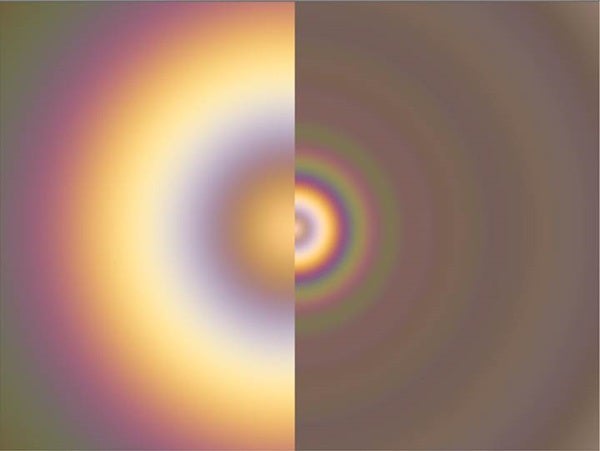These views simulate what glories would look like on Venus (left) and Earth (right).
A rainbow-like feature known as a glory has been seen by ESA’s Venus Express orbiter in the atmosphere of our nearest neighbor — the first time one has been fully imaged on another planet.
Rainbows and glories occur when sunlight shines on cloud droplets — water particles in the case of Earth. While rainbows arch across wide swathes of the sky, glories are typically much smaller and appear as a series of colored concentric rings centered on a bright core.
Glories are only seen when the observer is situated directly between the Sun and the cloud particles that are reflecting sunlight. On Earth, they are often seen from airplanes, surrounding the shadow of the aircraft on the clouds below or around the shadow of climbers atop misty mountain peaks.
A glory requires two circumstances: The cloud particles must be spherical, and therefore most likely liquid droplets, and they must all be of a similar size.
The atmosphere of Venus is thought to contain droplets rich in sulphuric acid. By imaging the clouds with the Sun directly behind the Venus Express spacecraft, scientists hoped to spot a glory in order to determine important characteristics of the cloud droplets.
They were successful. At the Venus cloud tops, 43 miles (70 kilometers) above the planet’s surface, the orbiter spotted a glory July 4, 2011. It is 740 miles (1,200km) wide as seen from the spacecraft, 3,730 miles (6,000km) away.
From these observations, the cloud particles are estimated roughly a fiftieth of the width of a human hair.
The glory’s width means that the particles at the cloud tops are uniform, at least on this scale.
The rings’ variations of brightness are different than those expected from clouds of only sulphuric acid mixed with water, suggesting that other chemistry may be at play.
One idea is that the cause is the “UV-absorber,” an unknown atmospheric component responsible for mysterious dark markings seen in the cloud tops of Venus at ultraviolet wavelengths. More investigation is needed to draw a firm conclusion.











